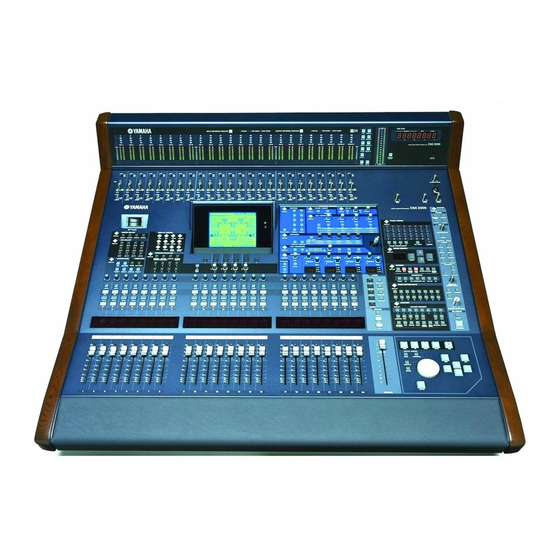
Table of Contents
Advertisement
Quick Start Guide
This is a "quick start guide" designed for people about to use Yamaha DM2000 for the first time. It is
not a guide to audio mixing and it assumes the reader has experience of analog mixers. It does not
replace the manual; we recommend referring to the manual if further information is required.
402 pages of manual and then the
editor and driver guides. Mmmmm.....
there has got to be a quicker way...
Advertisement
Table of Contents

Summarization of Contents
Getting Started and Hardware Overview
Getting Started with a 'blank' desk
How to erase memories or recall Scene 00 for factory settings.
Understanding the Rear Panel
Overview of audio connectors and ports on the rear panel.
Console Layout and Channel Interface
Understanding the Front Panel
Details the layout and main control areas of the console's front panel.
SELECTED CHANNEL area
How to use the SELECTED CHANNEL area for detailed control.
Fader Control and Input Assignment
Controlling Channel Faders
Explains the 9 fader layers and how faders control different inputs.
Changing INPUT PATCH
Step-by-step guide on assigning different inputs to input channels.
Output Configuration and Channel Naming
OUTPUT PATCH
How to assign output channels to OMNI or SLOT outputs.
CHANNEL NAMES
How to assign names to channels displayed on the console.
Encoder and Fader Mode Operations
ENCODER MODE / FADER MODE
Explains how encoders can edit parameters like PAN and AUX SEND.
Detailed Channel Parameter Control
Using the SELECTED CHANNEL controls
How to use the SELECTED CHANNEL area for detailed control.
EQUALIZER
Details the EQ edit page and parametric band adjustments.
Auxiliary and Matrix Send Configuration
AUX/MATRIX SEND
How to adjust Aux and Matrix send levels and status.
Routing and Signal Flow
ROUTING
How to route channels to Buses, Stereo Bus, or Direct Outputs.
PHASE / INSERT
How to manage phase reversal and insert points for channels.
DELAY
How to use and set the delay function for channels.
Channel Pairing and Grouping
CHANNEL PAIR
How to pair channels for stereo operation.
FADER GROUPS
How to group faders for simultaneous control.
MUTE GROUPS
How to group channels for simultaneous muting.
Effects Processing
EFFECTS
Overview of the 8 multi-effects units available.
EDITING AN EFFECT
How to edit effect parameters using encoders and arrow buttons.
Using Effects in the Mix
USING AN EFFECT
How to patch and use effects within the mixer.
Routing Audio Through Effects
ROUTING AUDIO THROUGH AN EFFECT
Step-by-step guide to sending audio through an effect.
Graphic Equalizers
GRAPHIC EQUALIZERS
How to access and use the 6 graphic equalizers.
Scene Management
SCENE MEMORY
How to store and manage mixing scenes.
RECALL SAFE
How to protect specific parameters from being overwritten.
Scene Operations and Manipulation
SCENE FADE
How to program fader movements to fade in or out over time.
SCENE COPY / PASTE
How to copy parameters or entire scenes between memories.
Monitoring Functions
MONITOR
How to select and control audio listening levels and sources.
User Defined Keys and Shortcuts
USER DEFINED KEYS
How to program custom shortcuts for frequently used functions.
DM2000V2 Short-Cut List
A list of quick methods for common operations.
Using the 'SEL' switches
Shortcuts related to the channel SELECT buttons.
Other Short-Cuts
Various other quick tips and shortcuts.
Additional Operational Tips
Other Tips
Additional tips for efficient use of the console.











Need help?
Do you have a question about the DM2000VCM and is the answer not in the manual?
Questions and answers